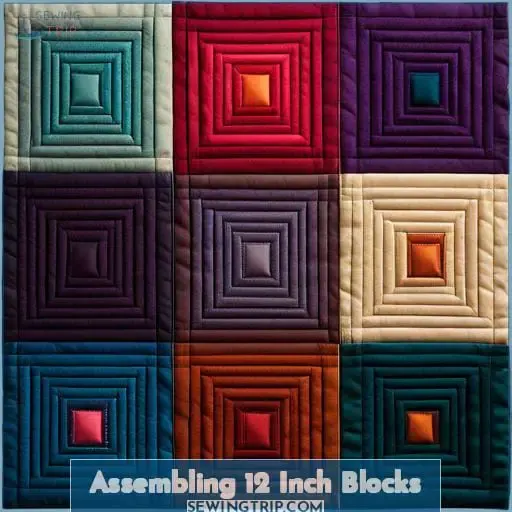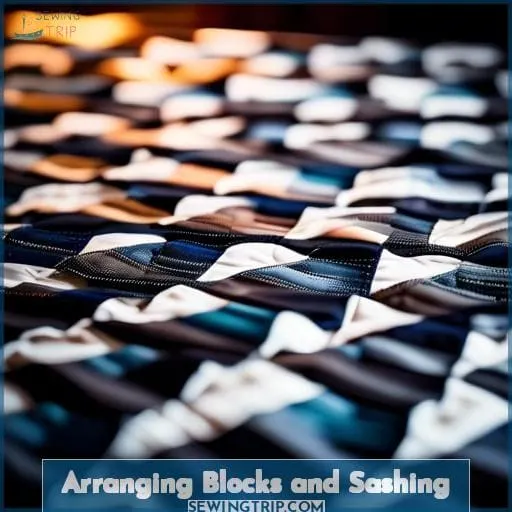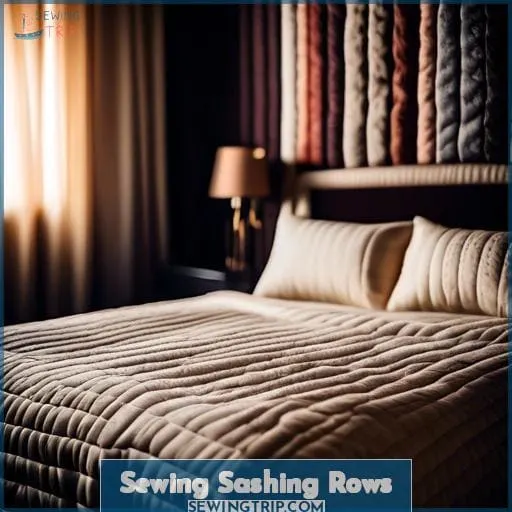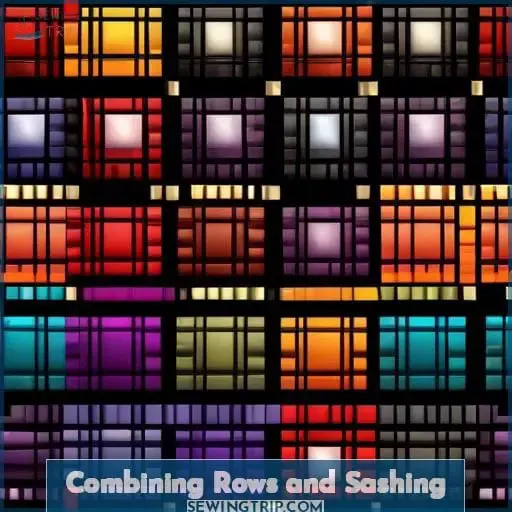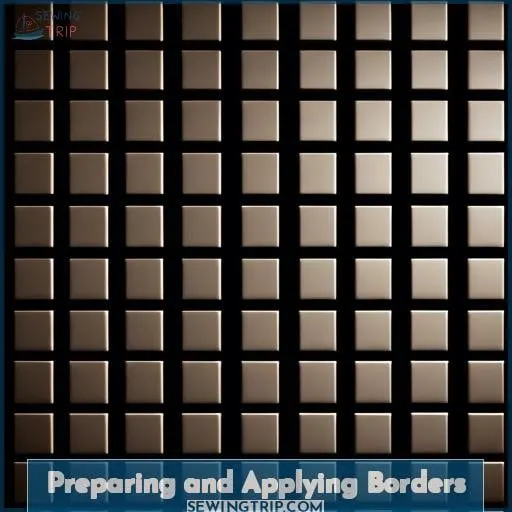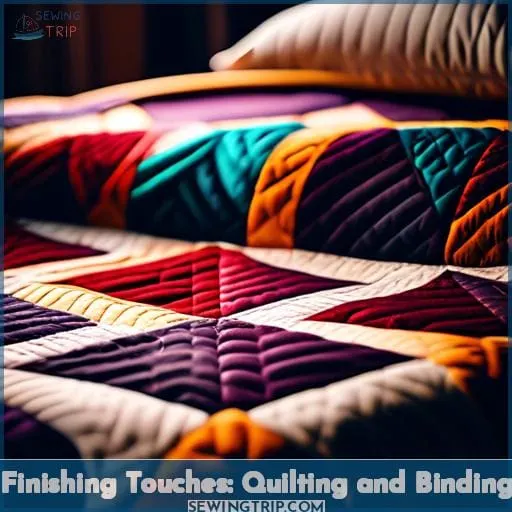This site is supported by our readers. We may earn a commission, at no cost to you, if you purchase through links.
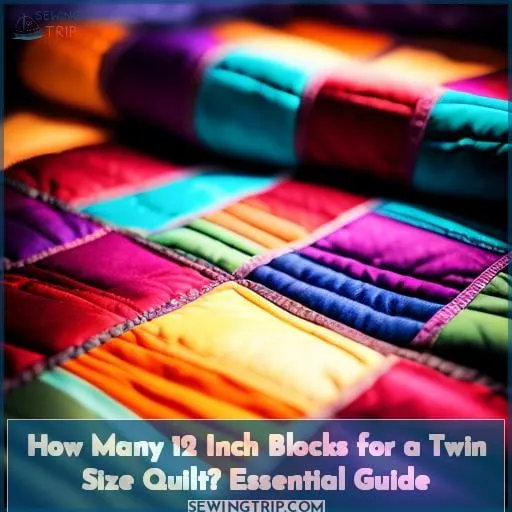 Dive into the craft of quilting as we explore how many 12-inch blocks you need for a twin size quilt.
Dive into the craft of quilting as we explore how many 12-inch blocks you need for a twin size quilt.
This essential guide breaks down the process, offering clear, accurate steps to achieve your quilting goals. Whether you’re a seasoned quilter or just starting, understanding the right number of blocks ensures your project aligns with your vision.
Let’s demystify the process together, turning your creative ideas into a beautifully crafted twin size quilt.
Table Of Contents
- Key Takeaways
- Understanding Quilt Sizes
- Twin Size Quilt Dimensions
- Essential Materials for a Twin Quilt
- Assembling 12 Inch Blocks
- Arranging Blocks and Sashing
- Sewing Sashing Rows
- Combining Rows and Sashing
- Preparing and Applying Borders
- Finishing Touches: Quilting and Binding
- Frequently Asked Questions (FAQs)
- Conclusion
Key Takeaways
- Twin quilt size recommendations aim for dimensions of 81 x 106 inches, with 12-inch blocks being a common choice for such quilts.
- A twin size quilt can be constructed using either 63 or 42 blocks of 12 inches, depending on the design and layout.
- Essential materials for assembling a twin quilt include sashing fabric, cornerstone fabric, border fabrics, 5 yards of backing, and 5/8 yard of binding.
- The assembly process emphasizes the importance of consistent seam allowances, strategic placement of sashing and cornerstone fabrics to enhance the quilt’s design, and the use of borders to frame the quilt effectively.
Understanding Quilt Sizes
When you’re diving into the quilting pool, it’s like sizing up a bed before a good night’s sleep—you need to know it’ll fit just right.
Quilt sizes are the cozy blueprints that align with bed sizes, ensuring your creation doesn’t hang too short or bunch up awkwardly. Think of mattress sizes as the canvas and quilt sizes as the frame; they’ve got to match to make the picture perfect.
For a twin size quilt, you’re playing with a space that’s snug for one, but just right for your 12-inch quilt blocks to shine. Whether you’re crafting for comfort or decorative purposes, knowing your quilt blocks will fit the twin bill without a hitch is like finding the missing puzzle piece in your quilt pattern adventure.
Twin Size Quilt Dimensions
Now, let’s dive into the specifics of twin size quilt dimensions. You’re crafting a cozy haven, a snuggle sanctuary if you will, and the size matters.
- Twin size measurements typically range from 39 x 75 inches for the mattress.
- Quilt dimensions can vary, but a common commercial size is around 81 x 106 inches.
- Recommended block sizes for a twin quilt often include 12 inch blocks.
- The block count for a twin quilt using 12 inch blocks is usually 63 or 42, depending on the desired drop.
- Quilt math is simple: for a twin size quilt, you’ll arrange your 12 inch blocks in block rows to achieve the desired twin size quilt dimensions.
Essential Materials for a Twin Quilt
You’ll need specific materials to assemble your twin size quilt with 12-inch blocks.
sashing,
cornerstone,
border fabrics,
as well as backing and binding.
Sashing Fabric
After sizing up your quilt layout, let’s dive into sashing fabric. Choosing the right sashing width, color, and material can make your quilt pop.
Think of sashing as the quilt’s frame, highlighting each block’s beauty.
Cornerstone Fabric
Next up, let’s chat about cornerstone fabric—your quilt’s unsung hero. Here’s the scoop:
- Placement: Cornerstone squares anchor your quilt design.
- Color Scheme: Choose hues that complement or contrast.
- Pattern Variation: Mix textures for a tactile twist.
Border Fabric
Choosing your border fabric is like picking the perfect frame for your masterpiece.
Mix and match border types and fabric choices, ensuring color combinations and pattern placement complement your quilting techniques.
Backing and Binding
For your twin quilt’s grand finale, pick fabric that sings in harmony with your blocks.
You’ll need 5 yards for backing and 5/8 yard for binding, ensuring your masterpiece is ready for showtime.
Assembling 12 Inch Blocks
Alright, let’s dive into the fun part: assembling your 12-inch blocks for that cozy twin size quilt.
Picture this: you’ve got your fabric selection spread out like a painter’s palette, bursting with colors that’ll make your quilt sing. Now, focus on block arrangement; it’s like a puzzle where each piece is crucial.
Ensure your seam allowance is as consistent as a baker’s recipe—this isn’t the time for a close enough attitude.
As you piece together each block, think about the sashing placement. It’s the secret ingredient that frames your blocks, turning a bunch of squares into a masterpiece.
Arranging Blocks and Sashing
When you’re piecing together your twin size quilt, think of block placement as the puzzle’s foundation. You’re not just throwing colors and patterns willy-nilly; you’re crafting a visual feast.
Imagine your blocks as the main course and the sashing as the seasoning that brings it all together. The sashing size should be just right—not too thick, not too thin—creating a harmonious flow between blocks.
As you lay out your pattern, play with color combinations like a chef experiments with flavors. Remember, sashing between blocks isn’t just filler; it frames each piece, making the full quilt pop.
Borders are the final touch, encapsulating your masterpiece. So, grab your fabric, and let’s make that twin size quilt a showstopper!
Sewing Sashing Rows
After you’ve laid out your 12-inch blocks in a pleasing pattern, it’s time to dive into sewing sashing rows.
Think of sashing as the glue that holds your quilt’s story together. For your twin size quilt, you’ll be creating sashing rows that not only add structure but also introduce an opportunity for creativity.
Choose sashing placement that complements your blocks, mixing and matching color combinations and fabric textures for an eye-catching effect.
Combining Rows and Sashing
Once you’ve got your sashing rows and block rows ready, it’s time to bring them together. Think of it as a dance where each step is crucial to the final performance. Start by laying out your sashing rows and block rows alternately, ensuring the color coordination and fabric selection sing in harmony.
Join the rows with precision, like connecting the dots in a constellation, creating a stellar quilt design. As you combine each row, consider the design variations that emerge. This isn’t just about making a twin size quilt; it’s about crafting a masterpiece with your 12 inch blocks.
Preparing and Applying Borders
Now, let’s dive into the art of preparing and applying borders to your twin size quilt. This step transforms your quilt from a patchwork puzzle into a masterpiece ready for the quilt show spotlight.
- Measure Twice, Cut Once: Determine your border length and width carefully. Remember, an accurate seam allowance is your secret weapon for a perfect fit.
- Selecting Your Fabric: Choose a border style and fabric selection that complements your 12-inch blocks, turning heads and warming hearts.
- Sewing with Heart: As you stitch, imagine the stories your quilt will tell, the comfort it will provide, and the awe it will inspire at every glance.
Borders are more than just fabric edges; they’re the final flourish that frames your labor of love.
Finishing Touches: Quilting and Binding
Once you’ve pieced together your quilt top and added the borders, you’re ready to bring it all together.
Now, it’s time to quilt according to the quilting instructions. This is where your quilt starts to take on character and texture. After quilting, trim the edges and prepare for binding. Binding techniques will give your twin size quilt a neat finish.
| Step | Material | Action |
|---|---|---|
| 1 | Batting | Lay and smooth |
| 2 | Quilt Top | Align with batting |
| 3 | Backing | Place over quilt top |
| 4 | Quilting | Follow instructions |
| 5 | Binding | Apply techniques |
Frequently Asked Questions (FAQs)
Can I mix different fabric types?
Yes, you can mix different fabric types in a quilt, but it’s a bit like cooking with diverse ingredients; some combinations work better than others.
Pre-washing and careful pressing are your best friends here.
How do I calculate batting size?
To calculate batting size for a twin quilt, add 6 inches to both the width and length of your quilt dimensions.
What thread count is best for quilting?
For quilting, a thread count around 68 x 68 per square inch hits the sweet spot—sturdy yet workable.
Avoid extremes; too low and it’s flimsy, too high and you’ll wrestle with the needle.
How do I prevent fabric shrinkage?
To dodge fabric shrinkage like a pro, prewash your quilting materials in cold water and air dry or tumble on low.
It’s like avoiding a rainstorm—preparation is key to staying dry and happy!
Are pre-cut quilt kits worth it?
Pre-cut quilt kits are a game-changer, especially if you’re all thumbs at picking fabrics or tight on time.
They’re your shortcut to a masterpiece, minus the headache of matching and measuring.
Worth every penny!
Conclusion
Crafting your twin size quilt with 12-inch blocks is a journey of creativity and precision. You’ve learned the dimensions, gathered essential materials, and mastered the assembly of blocks and sashing.
Now, as you arrange, sew, and finish your quilt, remember that each step brings you closer to a masterpiece. With the right number of 12-inch blocks in your twin size quilt, you’re not just making a blanket; you’re weaving warmth, comfort, and personal expression into every stitch.




